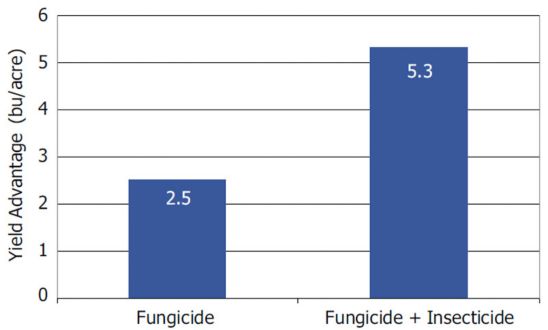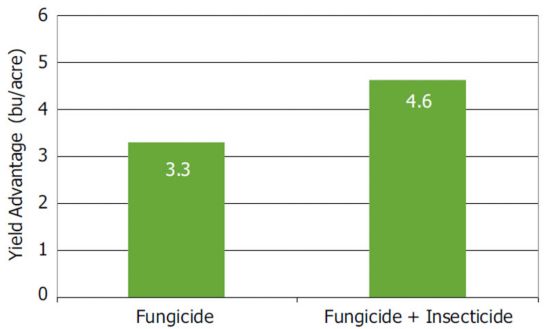Soybean insecticide applications have increased in recent years throughout most of North America, mainly due to a rise in soybean aphids. Growers and researchers are exploring the benefits of insecticide use, particularly by including an insecticide with a fungicide application.

Although this practice is efficient from an application standpoint, growers should be aware that a precise timing is usually required for optimum effectiveness of both components. However, insecticide applications are unlikely to be economically beneficial if pest pressure is low.
To better understand the potential yield benefits of insecticides applied with foliar fungicides, Pioneer conducted on-farm and small-plot research trials over multiple years and locations.
On-farm trials. Researchers conducted 200 on-farm trials over 4 years – 148 with only a fungicide and 52 with a fungicide + insecticide treatment. In these studies, the average yield response to a fungicide application was 2.5 bu/acre, compared to 5.3 bu/acre when an insecticide was also included (Figure 1).

Figure 1. Average soybean yield response to foliar fungicide and fungicide + insecticide treatments across 200 on-farm trials conducted over 4 years.
Small-plot trials. Over 5 years, small-plot replicated trials conducted in Illinois, Indiana, Iowa and Minnesota also showed an advantage for including an insecticide in the treatment (Figure 2).

Figure 2. Small-plot yield advantages with fungicide and fungicide + insecticide applications averaged over a 5-year period.
This study included 1 location where high soybean aphid pressure was observed. Yield response to insecticide treatment was much greater at this location than at locations with little or no aphid pressure (Figure 3).

Figure 3. Pioneer small-plot research trials average soybean yield response to foliar fungicide + insecticide application vs. fungicide only. Also comparing a location with high aphid pressure to locations with low or no aphid pressure.
Soybean aphid management. For an insecticide application to provide an economic benefit, it is recommended to treat only if populations exceed the economic threshold (ET). For soybean aphids, the ET is currently established at 250 aphids/plant (average of 20 to 30 plants/field) during the R1 to R5 growth stages. If this threshold is exceeded, treating within 7 days is required to prevent populations from reaching the Economic Injury Level (EIL) where yield loss exceeds the cost of treatment.
Hybrid and variety responses are variable and subject to any number of environmental, disease and pest pressures. Individual results may vary.
The foregoing is provided for informational use only. Please contact your Pioneer sales professional for information and management suggestions specific to your operation.